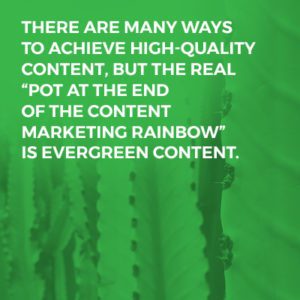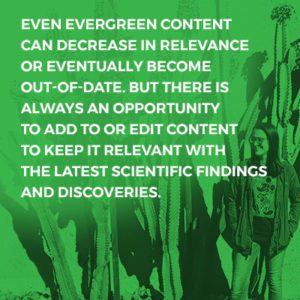

How to Incorporate Evergreen Content into Your Life Science Content Marketing Strategy
The ability to self-publish content instantly, with the click of a mouse, can be a blessing: it means that anyone can create thoughtful, high-quality content that audiences find valuable. On the flip side, it can be a curse for brands whose time and money can get sucked into low-quality content that holds no interest for their audience. Without audience interest, the content is sure to fade into irrelevance under the deluge of competing content that inundates your audience on a daily basis.

How can you generate content that is the former rather than the latter? There are many ways to achieve high-quality content, but the real “pot at the end of the content marketing rainbow” is evergreen content.
What is Evergreen Content?
For your audience, evergreen content is just what it sounds like. It’s content that doesn’t age and has long-term relevance, helping them to solve problems and move forward in their buying journey. Due to its relevance and utility, evergreen content is designed for audiences to share it, email it to a friend, and/or refer back to it over and over.
For content marketing, evergreen content (sometimes called cornerstone content), is content that drives constant traffic to your site, earns you links from other websites and social shares, and fills your sales funnel. All of these things can help your search engine optimization (SEO) efforts and increase your ROI on content marketing.
Evergreen Content Examples in the Life Science Industry
Evergreen content can come in many forms including, infographics, videos, “how-to” guides, webinars or short-form blogs. The basic premise is that it is both relevant and useful for your audience. If you’ve spent time in a research laboratory, chances are you’ve encountered evergreen content without even knowing it. Let’s take a look at some evergreen content examples in the life science content marketing arena.
Pioneers in Evergreen Content: New England Biosciences (NEB)
The lab where I did my Ph.D. had a poster from NEB that was torn, old, and had probably been there for decades. Without getting too much in the weeds, the poster told you which specific buffer you needed to use when digesting DNA with a NEB enzyme. This was incredibly useful for me and many other molecular biologists, because if you used the wrong buffer, certain enzymes wouldn’t work and you may waste your whole day.
Despite it’s worn nature, every member of my former lab used the poster on a day-to-day basis. NEB has moved on from their physical poster to become kings of online evergreen content. They have online tools & resources that include FAQs, protocols, selection charts, and interactive planning and data analysis tools. Ultimately, these resources help researchers make decisions about experiments, but also help them to select the right NEB product for their project. Now, that is some valuable (yet free!), evergreen content.
Making Decisions About Antibiotics: Millipore Sigma
For researchers in many different fields, choosing the right antibiotic for your project is a critical first step in experimental planning. To help in the selection process, Millipore Sigma has a great Antibiotics Selection Guide, which divides antibiotics up by mechanism of action and spectrum of activity. In addition, they provide a number of informational, written content pieces on using antibiotics in various types of cell culture. Antibiotics have long been a staple of most research labs, so having this rich content on how to choose the right antibiotic provides value and relevance for most researchers.
CRISPR and Genome Engineering: Synthego
With the explosion of CRISPR and other cell engineering tools for research, it’s become clear that CRISPR is much more than a passing fad. Accordingly, Synthego, which sells a variety of genome editing tools and engineered cells, has created e-book content about using CRISPR for research and cell engineering. This is another example of evergreen content creation that addresses the needs of those who may be peripherally aware of CRISPR, but have not yet made use of it in their research projects.
What Evergreen Content Isn’t
While it’s useful to understand and identify some evergreen content examples, there are a lot of things that it isn’t.
The following are not pieces of evergreen content:
- News articles
- Explanation of recent research findings
- Holiday/seasonal pieces
- Current trends or annual reports/articles
Basically, anything that has short-term relevance isn’t evergreen content, which raises an interesting point for niche industries like life science where new research is always being performed and the understanding of science is constantly evolving. How can you create evergreen content under these conditions?


Considerations for Generating Evergreen Content
Evergreen content is an essential part of any effective content marketing strategy. Here are a few things to think about when coming up with ideas for and creating evergreen content.
Target the Right Stage of the Buyer’s Journey
Evergreen content typically targets an audience that is in the awareness phase of the buyer’s journey. This means that selecting a topic for your evergreen content is a particularly important part of the process: you need a topic that is broad enough so that it captures the interest of your audience in the awareness phase, but not too broad as to capture students who are writing a term paper for their high-school biology final. Here are some tips to keeping it targeted to the right audience members:
- Talk to your current customers and find out what their pain points are at the early stage of the buyer’s journey. What content will help them? What content format would they prefer, and what terms and materials do they search for when looking for information online?
- Avoid technical jargon that your audience may not understand.
- Audit your current content that has been useful for attracting your audience. Consider how all of this content fits together and if it could be put together into a longer-form piece.
Keyword Research
When combined with SEO techniques, like keyword research and strategy, evergreen content can be a powerful driver of organic traffic to your content and website. In niche industries like the life sciences, identifying the keywords that your audience is searching for can be particularly difficult, but the effort is well worth the potential value that it can bring to your sales funnel.
Here are a couple of strategies for uncovering keywords to use for your evergreen content:
- Check the queries and current content that is ranking in Google Search Results using your Google Search Console account. This can give you a good idea about keywords that you can target with your content.
- As you do keyword research, check out the “People Also Ask” featured snippets on the Google Search Results Page. These can help you uncover questions that potential customers are asking about a specific topic.
- Ask your audience directly what they are searching for when they’re at the beginning stages of their information-gathering journey.
Rework or Repurpose Your Content
You may already be sitting on some great evergreen content. Look through your old content to see if it can be repurposed. Ask yourself these questions:
- Can we put this content in a different format that would appeal more to our audience?
- Is there a way we could “spin” our existing content to make it more appealing to those in the early stages of the buyer’s journey?
- Can we add additional content to refresh our existing content to make it more attractive to our audience?
In this way, you can create evergreen content without starting from scratch and without a massive outlay of cash.
Sustainability Through Evergreen Content
Evergreen content is a cost-efficient way to keep your audience going to your website, even when you aren’t posting new content. Importantly, it fulfills one of the core tenants of content marketing: to give your audience useful and relevant content for free. So, if you are in the life science industry, consider thinking about how to make evergreen content a part of your content strategy. And remember, evergreen content is only a small piece of content marketing. You still need topical forms of content for every phase of your buyers’ journey.
Is your content strategy missing evergreen content? Let’s brainstorm a way to generate content that will keep your audience coming back.
